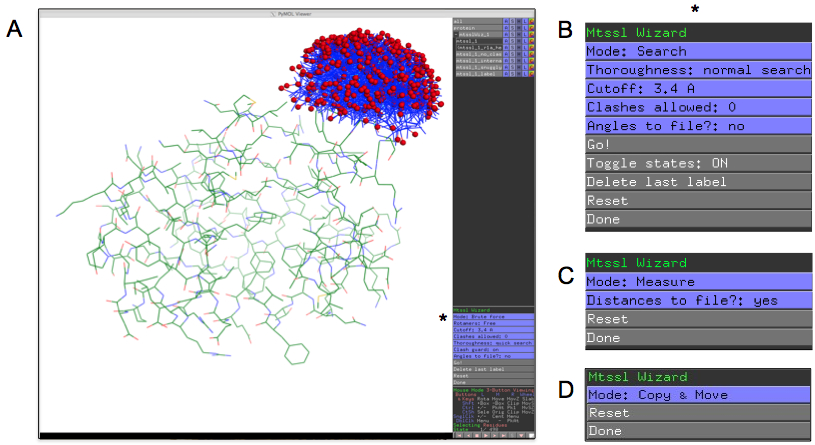This is a read-only mirror of pymolwiki.org
MtsslWizard
mtsslWizard
mtsslWizard is a PyMOL wizard for in silico spin labeling of proteins.
Program features
An MTSSL spin label can be attached to any position of a protein just by pointing and clicking. The program can then search the conformational space of the label (5 chi angles) and determine which conformations of the label do not clash with the protein surface. In "distance mode", distances between MTSSL ensembles can be determined and exported. For symmetric molecules, the MTSSL ensemble can be copied to symmetry related positions simply by pointing and clicking ("Copy & Move" mode).
Screen shot
Usage
labeling
- Open a protein structure in PyMOL and remove any unwanted solvent molecules or ligands.
- Start the mtsslWizard via Wizards>mtsslWizard
- If needed, vary the search parameters like "Thoroughness", "Cutoff" and "Clashes allowed". Thoroughness determines how many conformations of MTSSL will be checked. The cutoff value determines the minimum allowed distance between label and protein before the conformation is sorted out as clashing. "Clashes allowed" should usually be set to zero. If this value is changed to e.g. "5", a conformation can violate the "cutoff" parameter five times before the conformation is discarded.
- click "Go" to start the calculation. Depending on the size of the protein, the "Thoroughness" parameter and of course the speed of your computer the duration of the search can vary quite considerably. With the default settings it does usually not take longer than 10-15 seconds.
distance calculation
- change "Mode" to "Distance"
- click the first and second ensemble
- The program will now calculate all possible distances between the conformations in the two ensembles. If both ensembles have many conformations, this can take quite a while!
Reference
please read this paper for detailed information on the limitations of the approach: MtsslWizard: In silico Spin-Labeling and Generation of Distance Distributions in PyMOL. (2012) Appl. Magn. Res. accepted for publication
Contact
gh50'at'st-andrews.ac.uk
